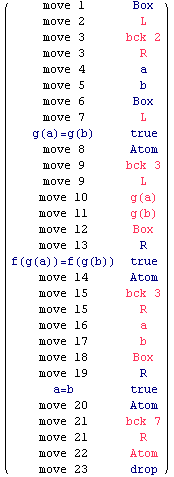![SetAbbreviation["Fun_f", Un["x", Un["y", Impl[" ... nj_g", Un["x", Un["y", Impl["g(x)=g(y)", "x=y"]]]] ;](../HTMLFiles/index_1532.gif)
Intuitionistic Logic: f function and fg injective imply g injective.
( Fun_f∧Inj_fg ⇒ Inj_g )
In this example we interpret a simple equational reasoning. Assume f is a function, and fg is injective, in order to prove that g is injective. Take any a, b, and assume g(a)=g(b), in order to prove a=b. Since f is a function, we have fg(a)=fg(b). Since fg is injective, we conclude a=b, as wished.
Below we interpret this equational reasoning as a recursive winning strategy for Eloise using intuitionistic backtracking.
There is a recursive winning strategy for Eloise. We do not describe it in full. The idea is that we read the proof itself as a strategy. Each time we invoke a particular hypothesis, or the thesis, we backtrack to it. The move by Abelard or Eloise corresponds to the logical rule we apply there.
In[395]:=
![SetAbbreviation["Fun_f", Un["x", Un["y", Impl[" ... nj_g", Un["x", Un["y", Impl["g(x)=g(y)", "x=y"]]]] ;](../HTMLFiles/index_1532.gif)
In[398]:=
![]()
Out[398]=
![]()
Out[399]=
![]()
Dotted positions (reminder). We mark with a big dot any position to which Eloise can backtrack to: all negative judgements of the tree, and the last positive judgement of the tree.
In[400]:=
![savedplay = ( "move 1" "Box" ) ; ... istic, ConstructiveImplication, CutFree", "TreeWidth=900, FontSize=12", savedplay]](../HTMLFiles/index_1536.gif)
![[Graphics:../HTMLFiles/index_1537.gif]](../HTMLFiles/index_1537.gif)
![]()
![[Graphics:../HTMLFiles/index_1539.gif]](../HTMLFiles/index_1539.gif)
![]()
![[Graphics:../HTMLFiles/index_1541.gif]](../HTMLFiles/index_1541.gif)
![]()
![[Graphics:../HTMLFiles/index_1543.gif]](../HTMLFiles/index_1543.gif)
![]()
![[Graphics:../HTMLFiles/index_1545.gif]](../HTMLFiles/index_1545.gif)
| Goal of: | Eloise |
![]()
![]()
![]()
| Goal of: | Abelard |
![]()
![]()
![]()
![]()
![]()
![]()
![]()
![[Graphics:../HTMLFiles/index_1556.gif]](../HTMLFiles/index_1556.gif)
![]()
![[Graphics:../HTMLFiles/index_1558.gif]](../HTMLFiles/index_1558.gif)
![]()
![[Graphics:../HTMLFiles/index_1560.gif]](../HTMLFiles/index_1560.gif)
| Goal of: | Eloise |
![]()
![]()
![]()
| Goal of: | Abelard |
![]()
![]()
![]()
![]()
![]()
![]()
![]()
![[Graphics:../HTMLFiles/index_1571.gif]](../HTMLFiles/index_1571.gif)
![]()
![[Graphics:../HTMLFiles/index_1573.gif]](../HTMLFiles/index_1573.gif)
![]()
![[Graphics:../HTMLFiles/index_1575.gif]](../HTMLFiles/index_1575.gif)
| Goal of: | Eloise |
![]()
![]()
![]()
| Goal of: | Abelard |
![]()
![]()
![]()
![]()
![]()
![]()
![]()
![]()
![[Graphics:../HTMLFiles/index_1587.gif]](../HTMLFiles/index_1587.gif)
![]()
![[Graphics:../HTMLFiles/index_1589.gif]](../HTMLFiles/index_1589.gif)
![]()
![[Graphics:../HTMLFiles/index_1591.gif]](../HTMLFiles/index_1591.gif)
| Goal of: | Eloise |
![]()
![]()
![]()
| Goal of: | Abelard |
![]()
![]()
![]()
![]()
![]()
![]()
![]()
![[Graphics:../HTMLFiles/index_1602.gif]](../HTMLFiles/index_1602.gif)
![]()
![[Graphics:../HTMLFiles/index_1604.gif]](../HTMLFiles/index_1604.gif)
![]()
![[Graphics:../HTMLFiles/index_1606.gif]](../HTMLFiles/index_1606.gif)
| Goal of: | Eloise |
![]()
![]()
![]()
| Goal of: | Abelard |
![]()
![]()
![]()
![]()
![]()
![]()
![]()
![[Graphics:../HTMLFiles/index_1617.gif]](../HTMLFiles/index_1617.gif)
![]()
![[Graphics:../HTMLFiles/index_1619.gif]](../HTMLFiles/index_1619.gif)
![]()
![[Graphics:../HTMLFiles/index_1621.gif]](../HTMLFiles/index_1621.gif)
| Goal of: | Eloise |
![]()
![]()
![]()
| Goal of: | Abelard |
![]()
![]()
![]()
![]()
![]()
![]()
![]()
![[Graphics:../HTMLFiles/index_1632.gif]](../HTMLFiles/index_1632.gif)
![]()
![[Graphics:../HTMLFiles/index_1634.gif]](../HTMLFiles/index_1634.gif)
![]()
![[Graphics:../HTMLFiles/index_1636.gif]](../HTMLFiles/index_1636.gif)
| Goal of: | Eloise |
![]()
![]()
![]()
| Goal of: | Abelard |
![]()
![]()
![]()
![]()
![]()
![]()
![]()
![[Graphics:../HTMLFiles/index_1647.gif]](../HTMLFiles/index_1647.gif)
![]()
![[Graphics:../HTMLFiles/index_1649.gif]](../HTMLFiles/index_1649.gif)
![]()
![[Graphics:../HTMLFiles/index_1651.gif]](../HTMLFiles/index_1651.gif)
| Goal of: | Eloise |
![]()
![]()
![]()
| Goal of: | Abelard |
![]()
![]()
![]()
![]()
![]()
![]()
![]()
![[Graphics:../HTMLFiles/index_1662.gif]](../HTMLFiles/index_1662.gif)
![]()
![[Graphics:../HTMLFiles/index_1664.gif]](../HTMLFiles/index_1664.gif)
![]()
![[Graphics:../HTMLFiles/index_1666.gif]](../HTMLFiles/index_1666.gif)
| Goal of: | Eloise |
![]()
![]()
![]()
| Goal of: | Abelard |
![]()
![]()
![]()
![]()
![]()
![]()
![]()
![[Graphics:../HTMLFiles/index_1677.gif]](../HTMLFiles/index_1677.gif)
![]()
![[Graphics:../HTMLFiles/index_1679.gif]](../HTMLFiles/index_1679.gif)
![]()
![[Graphics:../HTMLFiles/index_1681.gif]](../HTMLFiles/index_1681.gif)
| Goal of: | Eloise |
![]()
![]()
![]()
| Goal of: | Abelard |
![]()
![]()
![]()
![]()
![]()
![]()
![]()
![]()
![[Graphics:../HTMLFiles/index_1693.gif]](../HTMLFiles/index_1693.gif)
![]()
![[Graphics:../HTMLFiles/index_1695.gif]](../HTMLFiles/index_1695.gif)
![]()
![[Graphics:../HTMLFiles/index_1697.gif]](../HTMLFiles/index_1697.gif)
| Goal of: | Eloise |
![]()
![]()
![]()
| Goal of: | Abelard |
![]()
![]()
![]()
![]()
![]()
![]()
![]()
![[Graphics:../HTMLFiles/index_1708.gif]](../HTMLFiles/index_1708.gif)
![]()
![[Graphics:../HTMLFiles/index_1710.gif]](../HTMLFiles/index_1710.gif)
![]()
![[Graphics:../HTMLFiles/index_1712.gif]](../HTMLFiles/index_1712.gif)
| Goal of: | Eloise |
![]()
![]()
![]()
| Goal of: | Abelard |
![]()
![]()
![]()
![]()
![]()
![]()
![]()
![[Graphics:../HTMLFiles/index_1723.gif]](../HTMLFiles/index_1723.gif)
![]()
![[Graphics:../HTMLFiles/index_1725.gif]](../HTMLFiles/index_1725.gif)
![]()
![[Graphics:../HTMLFiles/index_1727.gif]](../HTMLFiles/index_1727.gif)
| Goal of: | Eloise |
![]()
![]()
![]()
| Goal of: | Abelard |
![]()
![]()
![]()
![]()
![]()
![]()
![]()
![[Graphics:../HTMLFiles/index_1738.gif]](../HTMLFiles/index_1738.gif)
![]()
![[Graphics:../HTMLFiles/index_1740.gif]](../HTMLFiles/index_1740.gif)
![]()
![[Graphics:../HTMLFiles/index_1742.gif]](../HTMLFiles/index_1742.gif)
| Goal of: | Eloise |
![]()
![]()
![]()
| Goal of: | Abelard |
![]()
![]()
![]()
![]()
![]()
![]()
![]()
![[Graphics:../HTMLFiles/index_1753.gif]](../HTMLFiles/index_1753.gif)
![]()
![[Graphics:../HTMLFiles/index_1755.gif]](../HTMLFiles/index_1755.gif)
![]()
![[Graphics:../HTMLFiles/index_1757.gif]](../HTMLFiles/index_1757.gif)
| Goal of: | Eloise |
![]()
![]()
![]()
| Goal of: | Abelard |
![]()
![]()
![]()
![]()
![]()
![]()
![]()
![[Graphics:../HTMLFiles/index_1768.gif]](../HTMLFiles/index_1768.gif)
![]()
![[Graphics:../HTMLFiles/index_1770.gif]](../HTMLFiles/index_1770.gif)
![]()
![[Graphics:../HTMLFiles/index_1772.gif]](../HTMLFiles/index_1772.gif)
| Goal of: | Eloise |
![]()
![]()
![]()
| Goal of: | Abelard |
![]()
![]()
![]()
![]()
![]()
![]()
![]()
![[Graphics:../HTMLFiles/index_1783.gif]](../HTMLFiles/index_1783.gif)
![]()
![[Graphics:../HTMLFiles/index_1785.gif]](../HTMLFiles/index_1785.gif)
![]()
![[Graphics:../HTMLFiles/index_1787.gif]](../HTMLFiles/index_1787.gif)
| Goal of: | Eloise |
![]()
![]()
![]()
| Goal of: | Abelard |
![]()
![]()
![]()
![]()
![]()
![]()
![]()
![]()
![[Graphics:../HTMLFiles/index_1799.gif]](../HTMLFiles/index_1799.gif)
![]()
![[Graphics:../HTMLFiles/index_1801.gif]](../HTMLFiles/index_1801.gif)
![]()
![[Graphics:../HTMLFiles/index_1803.gif]](../HTMLFiles/index_1803.gif)
| Goal of: | Eloise |
![]()
![]()
![]()
| Goal of: | Abelard |
![]()
![]()
![]()
![]()
![]()
![]()
![]()
![[Graphics:../HTMLFiles/index_1814.gif]](../HTMLFiles/index_1814.gif)
![]()
![[Graphics:../HTMLFiles/index_1816.gif]](../HTMLFiles/index_1816.gif)
![]()
![[Graphics:../HTMLFiles/index_1818.gif]](../HTMLFiles/index_1818.gif)
| Goal of: | Eloise |
![]()
![]()
![]()
| Goal of: | Abelard |
![]()
![]()
![]()
![]()
![]()
![]()
![]()
![[Graphics:../HTMLFiles/index_1829.gif]](../HTMLFiles/index_1829.gif)
![]()
![[Graphics:../HTMLFiles/index_1831.gif]](../HTMLFiles/index_1831.gif)
![]()
![[Graphics:../HTMLFiles/index_1833.gif]](../HTMLFiles/index_1833.gif)
| Goal of: | Eloise |
![]()
![]()
![]()
| Goal of: | Abelard |
![]()
![]()
![]()
![]()
![]()
![]()
![]()
![[Graphics:../HTMLFiles/index_1844.gif]](../HTMLFiles/index_1844.gif)
![]()
![[Graphics:../HTMLFiles/index_1846.gif]](../HTMLFiles/index_1846.gif)
![]()
![[Graphics:../HTMLFiles/index_1848.gif]](../HTMLFiles/index_1848.gif)
| Goal of: | Eloise |
![]()
![]()
![]()
| Goal of: | Abelard |
![]()
![]()
![]()
![]()
![]()
![]()
![]()
![[Graphics:../HTMLFiles/index_1859.gif]](../HTMLFiles/index_1859.gif)
![]()
![[Graphics:../HTMLFiles/index_1861.gif]](../HTMLFiles/index_1861.gif)
![]()
![[Graphics:../HTMLFiles/index_1863.gif]](../HTMLFiles/index_1863.gif)
| Goal of: | Eloise |
![]()
![]()
![]()
| Goal of: | Abelard |
![]()
![]()
![]()
![]()
![]()
![]()
![]()
![[Graphics:../HTMLFiles/index_1874.gif]](../HTMLFiles/index_1874.gif)
![]()
![[Graphics:../HTMLFiles/index_1876.gif]](../HTMLFiles/index_1876.gif)
![]()
![[Graphics:../HTMLFiles/index_1878.gif]](../HTMLFiles/index_1878.gif)
| Goal of: | Eloise |
![]()
![]()
![]()
| Goal of: | Abelard |
![]()
![]()
![]()
![]()
![]()
![]()
![]()
![[Graphics:../HTMLFiles/index_1889.gif]](../HTMLFiles/index_1889.gif)
![]()
![[Graphics:../HTMLFiles/index_1891.gif]](../HTMLFiles/index_1891.gif)
![]()
![[Graphics:../HTMLFiles/index_1893.gif]](../HTMLFiles/index_1893.gif)
| Goal of: | Eloise |
![]()
![]()
![]()
| Goal of: | Abelard |
![]()
![]()
![]()
![]()
![]()
![]()
![]()
![]()
![[Graphics:../HTMLFiles/index_1905.gif]](../HTMLFiles/index_1905.gif)
![]()
![[Graphics:../HTMLFiles/index_1907.gif]](../HTMLFiles/index_1907.gif)
![]()
![[Graphics:../HTMLFiles/index_1909.gif]](../HTMLFiles/index_1909.gif)
| Goal of: | Eloise |
![]()
![]()
![]()
| Goal of: | Abelard |
![]()
![]()
![]()
![]()
![]()
![]()
![]()
![[Graphics:../HTMLFiles/index_1920.gif]](../HTMLFiles/index_1920.gif)
![]()
![[Graphics:../HTMLFiles/index_1922.gif]](../HTMLFiles/index_1922.gif)
![]()
![[Graphics:../HTMLFiles/index_1924.gif]](../HTMLFiles/index_1924.gif)
| Goal of: | Eloise |
![]()
![]()
![]()
| Goal of: | Abelard |
![]()
![]()
![]()
![]()
![]()
![]()
![]()
![[Graphics:../HTMLFiles/index_1935.gif]](../HTMLFiles/index_1935.gif)
![]()
![[Graphics:../HTMLFiles/index_1937.gif]](../HTMLFiles/index_1937.gif)
![]()
![[Graphics:../HTMLFiles/index_1939.gif]](../HTMLFiles/index_1939.gif)
| Goal of: | Eloise |
![]()
![]()
![]()
| Goal of: | Abelard |
![]()
![]()
![]()
![]()
![]()
![]()
![[Graphics:../HTMLFiles/index_1949.gif]](../HTMLFiles/index_1949.gif)
![]()

Created by Mathematica (November 11, 2006)